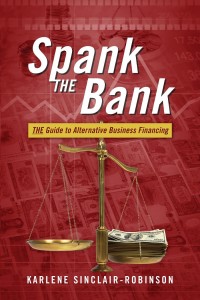Beyond Merchant Cash Advance: An Interview With Karlene Sinclair-Robinson
Guest: Karlene Sinclair-Robinson
 People come to me for advice on business lending quite often. I’ve spent years helping small business owners obtain financing, many of whom were turned down previously by a bank. And so the story has been told that if traditional lending doesn’t seem to be an option, there is an excellent Plan B, Merchant Cash Advance (MCA). The characteristics of an MCA have changed over the years though, by a wide margin.
People come to me for advice on business lending quite often. I’ve spent years helping small business owners obtain financing, many of whom were turned down previously by a bank. And so the story has been told that if traditional lending doesn’t seem to be an option, there is an excellent Plan B, Merchant Cash Advance (MCA). The characteristics of an MCA have changed over the years though, by a wide margin.
At one point in the past, they were discernibly different from a loan, and most often structured as a purchase of future credit or debit card sales. Factoring costs amongst funding providers were relatively uniform, and advances were estimated to completely pay off in 8 months or less. It’s different now. MCA has since been semantically broadened to include non-bank financial service programs that are structured as a loan. Factoring or interest rates costs vary widely, and terms can go out as long as 18 months.
But maybe you knew all that, and so when the follow up question becomes, “Sean, how else can I raise capital besides MCA?” I resort to throwing out buzz words such as Venture Capital financing or Peer-to-Peer lending. Oh I can tell you how these things work but certainly not with the amount of details that I could about MCA. As some folks depend on me to help them out and list all of their options, I find myself promising to send them “something” through e-mail later.
As I started drafting one e-mail, I began to wish there was a comprehensive book, one that I could simply recommend as an easy read to newly minted entrepreneurs and wise old business owners alike. It turns out that such a book exists and it’s got tons of tips that I hadn’t even thought of; It’s called Spank the Bank, by Karlene Sinclair-Robinson. I was so glad to have found it, that I went off in search of Karlene, hoping that she would be able to answer some of my questions. Luckily, she was nice enough to respond!
——————————-
Sean: Karlene, I can tell you from my experience in the MCA field that a lot of people looking to start a business hope that MCA is the answer when the bank turns them down, when in fact it is not. You list many alternative funding options in your book, so if an individual were interested in starting a restaurant or brick and mortar retail business, what 4 options would you recommend they try? Which one do you think they should try first?
Karlene: Sean, thanks for reaching out to me and spreading the word about my book, Spank The Bank. In response to your question, it reminds me of a jigsaw puzzle. Why you might ask? This is due, in part, to the type of business, industry, how much financing they need and who the new entrepreneur will be. There are variables that must be considered in order to decide on the best financing solutions. So, in order to help a restaurant startup or retail business, they should consider the following, if appropriate:
- Equipment Lease or Vendor Financing
- Franchise Financing
- Microloan or Peer-to-Peer Lending
- Private Commercial Loan
The great part about alternative financing is the ability to use more than one option at the same time to gain the financing needed.
Sean: You list Peer-to-Peer lending in your book as an alternative. I am familiar with Prosper.com, but are there any others that you know of? Do you have any tips to make such a lending campaign successful?
 Karlene: Great question. Yes, there are more Peer-to-Peer lending sites. Prosper.com is one of the two major sites I mention in the book. LendingClub.com is the other site borrowers should consider. They have funded over U.S. $1.5 billion as of this month. LendingClub.com hit the billion $$$ threshold on November 5, 2012, and so, in the space of just over 4 months have financed more than $500 million in loans. What is so unique about both sites is the maximum amount they can lend. Prosper lends up to $25,000 while Lending Club goes up to $35,000. Are they making a difference? Absolutely! By the way, this is not just a U.S. phenomenon, it is happening worldwide. Checkout Kiva.org
Karlene: Great question. Yes, there are more Peer-to-Peer lending sites. Prosper.com is one of the two major sites I mention in the book. LendingClub.com is the other site borrowers should consider. They have funded over U.S. $1.5 billion as of this month. LendingClub.com hit the billion $$$ threshold on November 5, 2012, and so, in the space of just over 4 months have financed more than $500 million in loans. What is so unique about both sites is the maximum amount they can lend. Prosper lends up to $25,000 while Lending Club goes up to $35,000. Are they making a difference? Absolutely! By the way, this is not just a U.S. phenomenon, it is happening worldwide. Checkout Kiva.org
Sean: You mentioned that a website is important to alternative financing sources. I find this very interesting and agree with you completely. I have gone so far as to suggest to my peers in lending that in 2013 and beyond, it does not make sense to approve a business that does not have a website, even if the business looks decent on paper. There is even one specialized MCA firm that I know of that actually evaluates the amount of Likes and Followers you have on social media in the application process. For a very small business that just needs to get their web presence up and running, how much do you think it would cost to do this and would they need to hire a designer or programmer?
Karlene: Thanks for agreeing with me on the website factor. I believe it should be a part of the due diligence process. In order to help those who are in need of website development, I suggest you check with you local area SCORE offices, Small Business Development Centers, Women’s Business Centers or other business affiliated sources that can give you a good reference to a web designer or use networking sources to help you find a competent one. Depending on what must be on the site, the price can range from $500 to as high as $10,000. No startup business needs to pay that much. Use a budget that is in line with what you need first; then add on what you want at a later date. Be sure to carefully read the web designer’s contract that outlines what they are going to do and the cost to you. Pay for services based on work completed. Most will require a down payment.
Sean: A tough question now. Is it feasible for an entrepreneur that literally has no capital of their own to invest in their startup to go out and raise 100% of the funds to see it through? I ask because I have heard this story a lot. “I have a great business plan but I have no funds to make it reality.” Do they need to save up their own money first to get started? Even alternative lenders like MCA firms prefer for a business owner to be personally financially invested. It makes them more confident that the owner will never give up.
Karlene: This is a great question Sean. Let us add to the question – how much are they seeking? Again, the type of business will also determine the funding possibilities. However, let me make this very clear: startups need to come to the financing table with something to back them. Whether you are using savings, family and friends, or your IRA, having some money in the transaction or added collateral appropriate to the financing option to be used, makes it more likely that the financing request will be approved.
Sean: I’ve heard all the rumors about SBA loans; That they take 6 months to get an approval, 9 months to get the funds, that the bank can change their mind at the last minute, etc. But i’ve also heard it can happen in a matter of days. What is the real story here?
Karlene: Yes, I have to agree, there are a lot of rumors or myths about the SBA. Since I do not work for the SBA nor any banks providing SBA guaranteed loans, I cannot give the facts on this question. However, I can say this: since all financing requests (traditional and non-traditional) goes through due diligence phases from pre-qualification, initial approval, committee review (if appropriate) to final approval for transfer of funds, depending on all parties involved, it can be fast or it can be slow. When borrowers are unwilling to provide financial records or don’t have the required collateral to make a transaction work, this can delay or stop the deal. I often tell borrowers, lenders are in the business of lending, the more qualified transactions they can approve; they will do so. If the borrower is not on par with their financial records, this can also slow down the process.
Sean: Great answer. I agree that part of how long an application process takes is on the shoulders of the applicant. The more prepared they are, the faster it should be. Any final words?
Karlene: Sean, I appreciate the invite to shed more light on this topic of alternative business financing. You offer a product that many non-banking customers can use. Finally, I’d like your audience to take from this conversation, if nothing else, the fact that they do have options available to help them. So when banks say ‘no’, they’ll know where to go.
Sean: Thanks so much for taking the time to speak with me personally and for answering several questions that tons of small business owners and even peers in my field find themselves asking at some point. You are doing so many good things out there to help people and your book is excellent.
——————————-
After our interview, I also got to sit in on a twitter talk show in which Karlene was a special guest. The show was #SmallBizChat, a weekly event at 8pm EST. You can read the extended interview between the host and Karlene at http://succeedasyourownboss.com/03/2013/where-to-go-when-the-bank-says-no-finding-alternative-funding-for-your-small-business/. I intend to join as many future events as possible. So if you stop by, please say hello. I am @financeguy74.
Bio
 Karlene Sinclair-Robinson, dubbed “The Queen of Business Financing” is the Bestselling Author of ‘SPANK THE BANK: The Guide to Alternative Business Financing’. She is considered a foremost expert on ‘Alternative Business Financing’ for startups, small businesses and struggling entrepreneurs. She is a speaker, instructor, business consultant and principal of KSR Solutions, LLC, based in Northern Virginia. She is also a top Twitter Business Financing source to follow via @KarleneSinRob. Website: http://www.SpankTheBankNow.com.
Karlene Sinclair-Robinson, dubbed “The Queen of Business Financing” is the Bestselling Author of ‘SPANK THE BANK: The Guide to Alternative Business Financing’. She is considered a foremost expert on ‘Alternative Business Financing’ for startups, small businesses and struggling entrepreneurs. She is a speaker, instructor, business consultant and principal of KSR Solutions, LLC, based in Northern Virginia. She is also a top Twitter Business Financing source to follow via @KarleneSinRob. Website: http://www.SpankTheBankNow.com.
Sean Murray is the President and Chief Editor of deBanked and the founder of the Broker Fair Conference. Connect with me on LinkedIn or follow me on twitter. You can view all future deBanked events here.































